Cloudify Composer Overview
Get the latest docs
You are looking at documentation for an older release. Not what you want? Go to the current release documentation.Cloudify Composer is an editor for creating Blueprint YAML files dynamically, using a drag and drop interface.
Cloudify Composer enables you to model topology for complex applications, and to add relevant lifecycle operations implementation via external plugins and scripts.
Among its drag-and-drop components are platform and network items such as compute node, database, web server, and so on. You can also add your own custom node type components, custom plugins and interfaces.
The generated output from Cloudify Composer is a downloadable TGZ archive containing a blueprint.yaml file that provides a TOSCA-based description for the application topology and its lifecycle management. In addition to YAML artifacts, the blueprint archive includes a blueprint package that contains multiple resources such as configuration and installation scripts (or Puppet Manifests, or Chef Recipes, etc..), code, and basically any other resource you require for running your application.
Logging In
The first time that you use Cloudify Composer, you must supply a username and a password. Use the following defaults:
Username: composer
Password: composer
When you have logged in to Cloudify Composer, the Topology page for the selected blueprint is displayed.
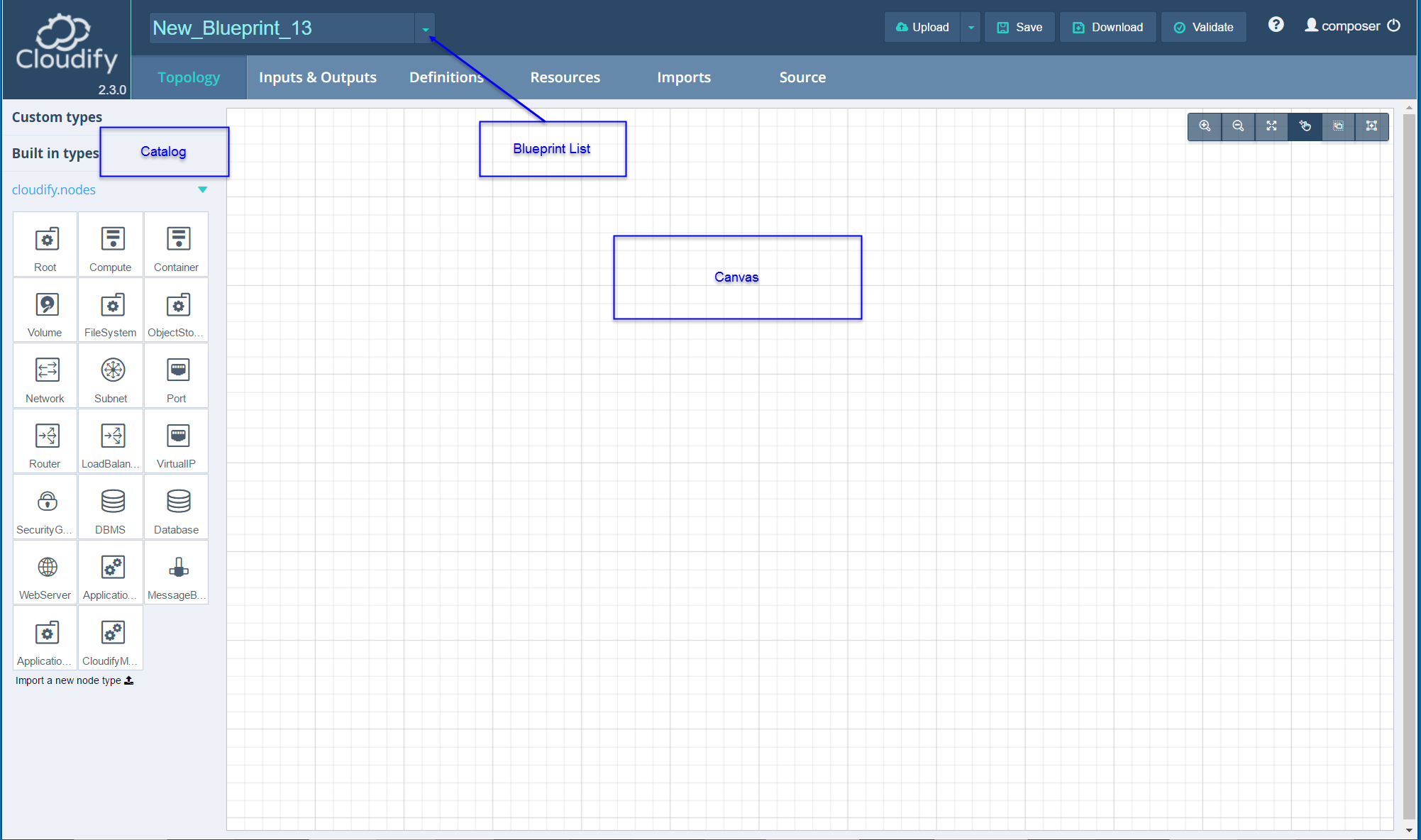
The left side of the Cloudify Composer Topology tab displays a Stencils catalog that contains node types that are used as the building blocks of the topology. The main pane on the tab is a canvas on to which you drag and drop nodes and define the relationships between them.
Workflow
This section describes the main functions related to creating a Blueprint. Typically, when you are using Cloudify Composer, your workflow will follow a similar order to that described in this section.
Additional functions, such as importing Stencils and Blueprints, and so on, are described after the primary functions related to creating a Blueprint.
Blueprints List
You can display the menu of all available blueprints that you created or imported by clicking the dropdown arrow next to the name of the currently displayed blueprint.
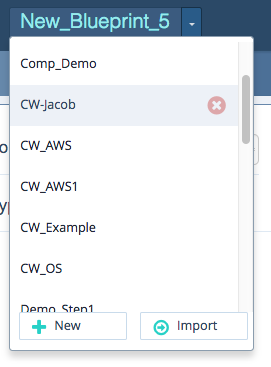
At the bottom of the list are buttons to enable you to create or import a blueprint.
Working with Nodes
You add a node by dragging the required node type from the Stencils panel and dropping it on canvas. You then click it to edit its properties. The properties that are available are dependent on the node type.
Depending on their type, you can add nodes inside other nodes. For example, a database server can be contained inside a compute node, a subnet node inside a network node, and a port node inside a subnet node. When a node is nested inside another node, a contained-in relationship is automatically generated between them.
You can define other relationships between nodes by clicking, holding and dragging the pointer from the right (exit) arrow of one node to the left (entrance) arrow of another. This action generates a connected-to relationship type.
To connect networks, subnets and ports to a platform node, click and drag a line from the VNIC square at the bottom of the node to the left (entry) side of the network. The connection is reflected as a colored square in the VNIC. Each square in the VNIC represents one connected network.
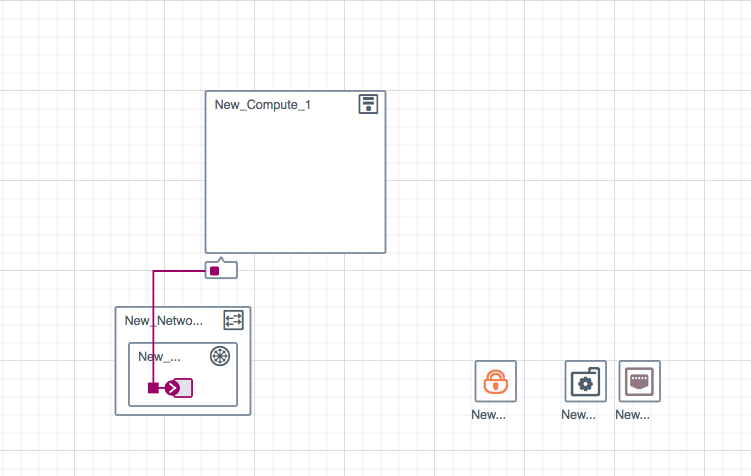
Adding Custom Node Types
You can add custom node types by creating new ones, or by importing them.
Creating a Custom Node Type
You create custom node types on the Definitions tab.
1 On the Definitions tab, click New Type.
2 Specify the settings for the new node type, including where it derives from, and any additional properties and interfaces.
3 Save the new node type.
The new node type appears in the Custom Types list in the Stencils panel. You can use it in the same way as the built-in node types, by dragging and dropping it onto the canvas.

Adding Plugins to the Blueprint Package
Adding a Plugin
You add plugins on the Definitions tab. Cloudify supports many plugins, which you can access here. In addition, you can create your own plugins.
Creating a Custom Plugin
1 Click Add Plugin and specify the following properties:
- The plugin file name
- The Executor
- The URL or a local archive of the specified plugin
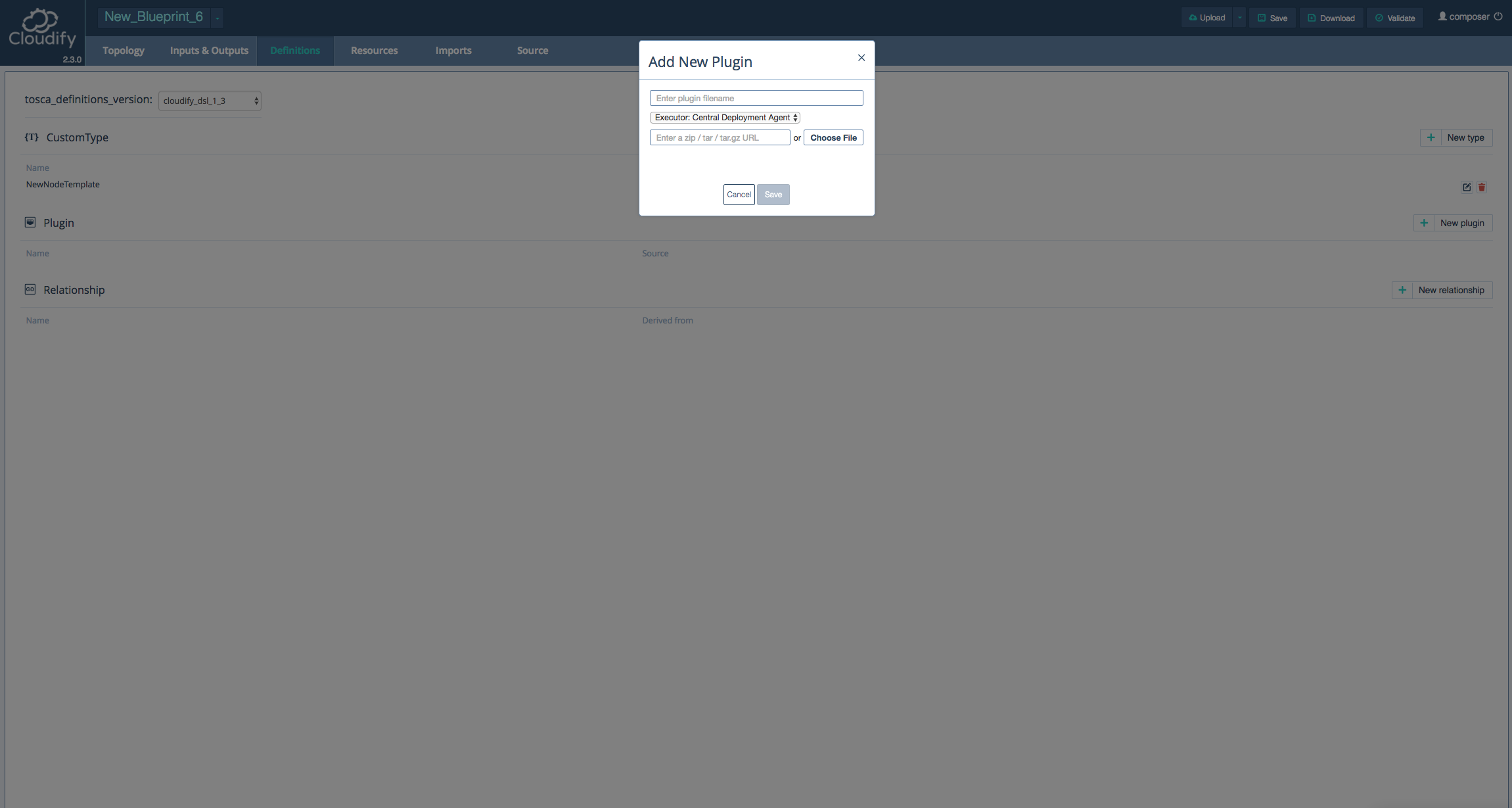 2 Click Save to save the properties that you have specified.
2 Click Save to save the properties that you have specified.
After a plugin is attached to a package, the operations it exposes appear in the interface’s operations implementations tree, as shown in the following screen capture.

Adding a Relationship Type
Custom Relationships, like types, derive from existing relationships and can also have additional properties and interfaces. Interfaces are defined per the source and target nodes that define the relationship.
Importing Stencils
You can import an external file that contains definitions of multiple node types to Cloudify Composer. Such files are referred to as stencils. After you have imported a stencil, it appears in the Imports list and you can see all the node types that were added, in their relevant node type group. The node types can be added to the Blueprint package.
Importing a Stencil
1 Click Import new node type at the bottom of the Stencils panel.
2 Specify a local file or a URL that contains node types and click Save.
Viewing Topology Source Code
Every addition or change that you make to the topology of your Blueprint package is reflected in code that you can see on the Source tab. This tab provides a representation of the generated TOSCA code behind the application modeling.
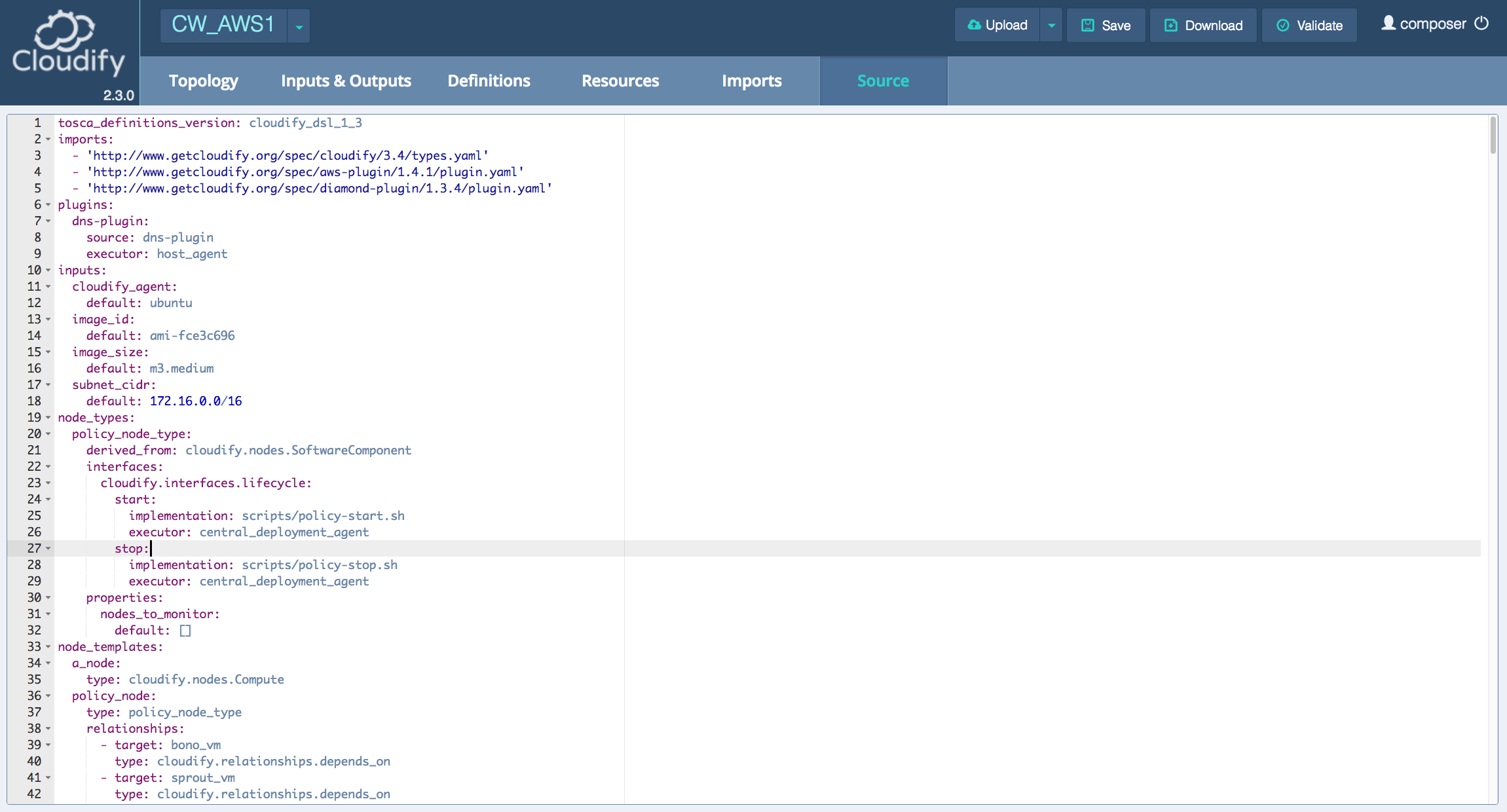
Node Settings
Clicking a node on the Blueprint canvas opens its settings window. The settings are divided into four sections.
Properties: The properties that were defined in the node type or its parents. Their values can be edited.
Interfaces: The interfaces and lifecycle events that are defined in the current node type or its parents. You can select the implementation to occur when a lifecycle operation is executed. You can add a script (that you have previously added to the “resources” tree on the Resources tab), or select a plugin’s operation implementation.
Relationships: The relationships of the current node. You can edit the relationships by clicking on a relationship connector, and changing its settings.
Networks and Network Components: The networks and networks’ components associated with the current node. For example, security groups and IP addresses. By adding one or more relevant components, you can assign them to the node and also see them reflected in the VNIC square.
Intrinsic Functions
As in Cloudify Manager, the values of a node’s properties, inputs or outputs can be specified as intrinsic function return values. The intrinsic functions list is available at http://getcloudify.org/guide/4.0/dsl-spec-intrinsic-functions.html.
Cloudify Composer auto-fills the functions and displays the available properties in the existing topology. Note that, for the get_attribute function you must be familiar with and use the run-time attributes’ names, not the auto-filled properties names. For example, to obtain a virtual IP address using the get_attribute function, use the run-time attribute VirtualIp_address, not the VirtualIP property.
Creating a Group
You can group a number of components using the “drag to select” button  . Select the required nodes and click on the “create group” button
. Select the required nodes and click on the “create group” button  to create a resource group in the topology view. The resource group is also created in the source code, which you can view on the Source tab. You can click the group to display its properties and add or remove members.
to create a resource group in the topology view. The resource group is also created in the source code, which you can view on the Source tab. You can click the group to display its properties and add or remove members.
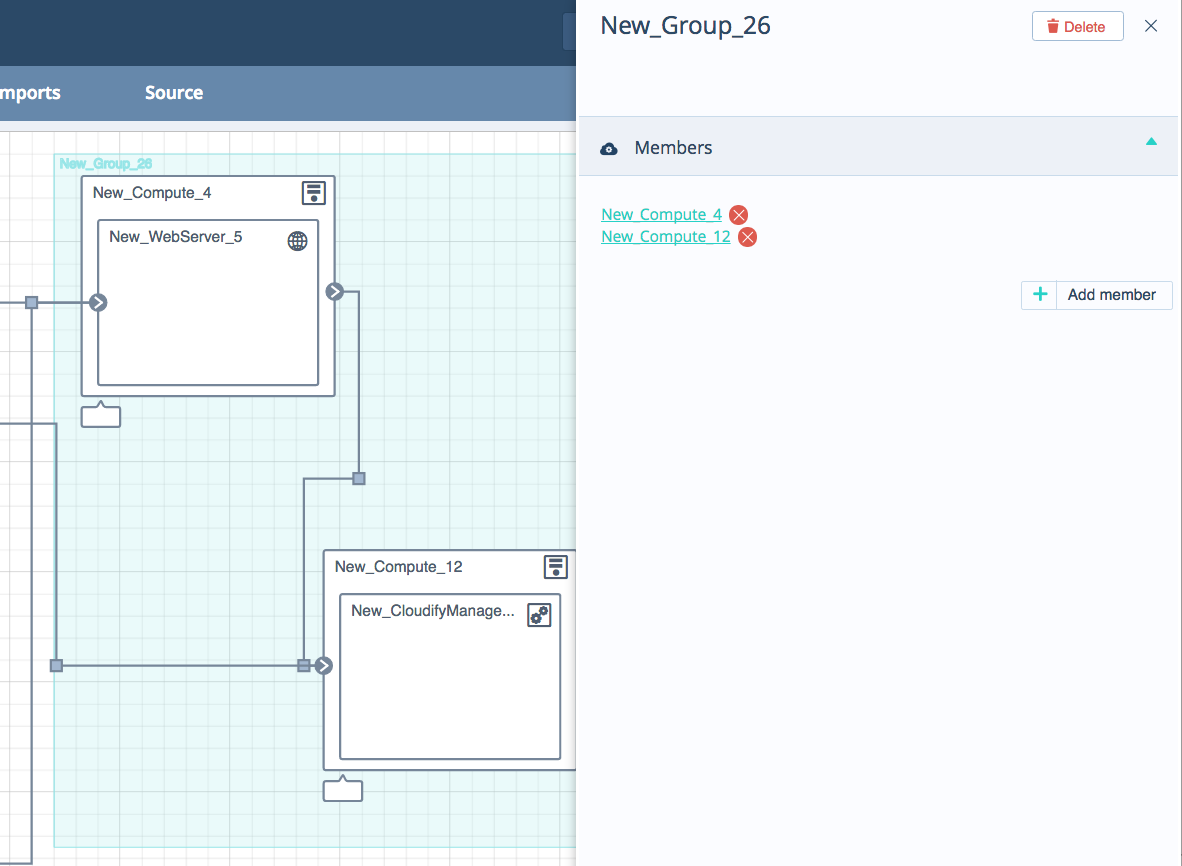
Inputs and Outputs
Cloudify Composer enables you to add inputs and outputs to the Blueprint on the Inputs & Outputs tab.
Inputs are parameters that are inserted into the Blueprint when a deployment is created. They are useful when you need to use information that is still unknown at the time that the Blueprint is created. Inputs can also be used to differentiate between deployments of the same Blueprint. You can reference inputs from other parts of the topology, using the get_input intrinsic function.
Outputs provide a way to expose the global aspects of a blueprint’s deployment, such as the endpoint of a server or other runtime or static information for a specific resource.
Inuputs and outputs can be referenced from other parts of the topology, using the get-input intrinsic function.
Uploading, Saving, Downloading and Validating Blueprints
Use the buttons on the top right of the Cloudify Composer screen to upload a blueprint to Cloudify Manager, or to save, download or validate a blueprint.
Note
Cloudify Composer 2.3 supports uploads to Cloudify Manager 3.x.
The download operation downloads the last saved blueprint package as a TAR archive.
Validating a blueprint reviews the source code, to ensure that logical concepts are valid.
